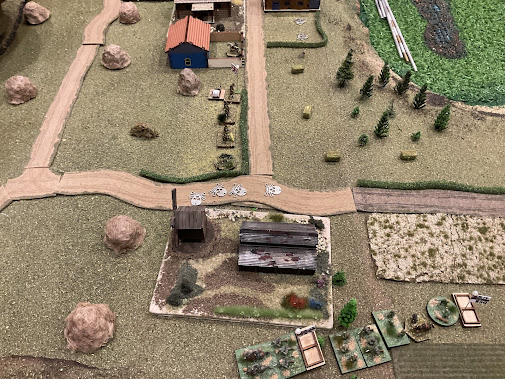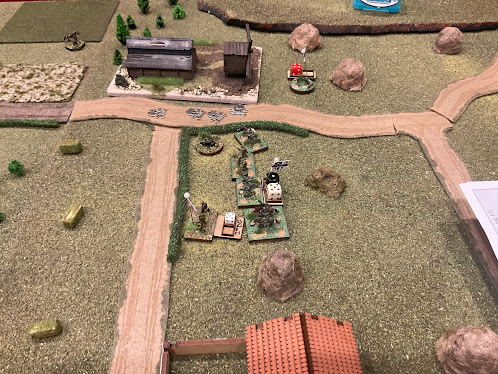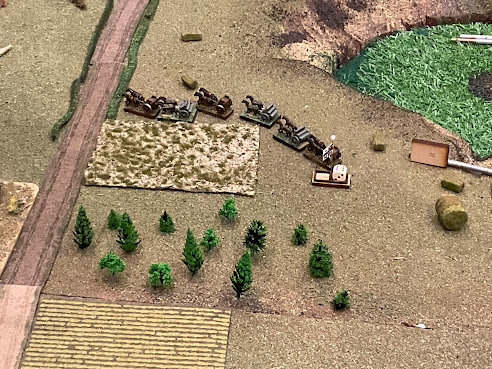Toy Soldiers for Old Gits!
Welcome to “Toy Soldiers for Old Gits” or what we call TSOG! This is a place where A handful of regular guys henceforth known as the Old Gits will ramble on about all scales of Toy Soldiers, various War Game Rules, record their AAR’s and comment on all manner of other war gaming stuff in general. Should be fun for every war gamer on the Inter Web...hmmm do people still say that? Anyway read on and enjoy!
Friday, 28 March 2025
ACW AAR 61 to 65 Rules Fence-Line Defence Variation
Thursday, 7 November 2024
Strangers in the Night, well Daytime! - A Men Who Would Be Kings Rules AAR
British Force
Tuesday, 17 September 2024
TGAA - ‘Battle of Hyde Park’ Scenario & AAR
Action:
Battle of Hyde Park
Date: Monday June 6 1932
Location: Hyde Park, Sydney NSW
Factions: NSW State Government vs Unionists
As New South Wales’ Constitutional Crisis entered into its Second week the situation within the inner Sydney was becoming more heated on a daily basis. After the May 28 riots Hyde Park and its environs drew every manner of revolutionary group to it. Brawls and fire fights were common occurrences as these factions crossed into each other’s patch of the Park. The area around the proposed ANZAC Memorial was a sort of neutral zone as many of the revolutionaries had served in the Great War so it remained relatively quiet, well it was until June 2nd when Unionist made their camp just north of Emden Memorial.
The
Unionists under the direction of their elected leaders, Benjamin Hill and
Richard Emery barricaded their selected area and their entrenchments were
nicknamed the Eureka Stockade. The location of the Unionists fortifications
alarmed the nearby residents and rumours spread quickly that they were going to
take control of the old Emden Gun and start shelling the city with it! Panic
amongst the locals spread quickly even though Government Officials issued
notices trying to calm them explaining that the old gun was deactivated and that
there was actually to fear from it. Despite the State Government’s statements
growing trepidation took hold and the powers to be were under increased
pressure to dislodge the Unionists from their encampment.
On
Monday June 6 Police and Fire Department Detachments under the command of Detective Super
Intendant Morecambe Wise were ordered to the area and to clear out the Unionists.
Wise collected his forces at the corner of College and Liverpool Streets and
planned to strike at the Unionists from there. Wise cunningly organised a
diversion, members of Sydney’s Chinese community supported by a Lewis Gun Team
under the command Inspector David Allen were to assail the Stockade area from
the North and distract the defenders!
As twilight grew on June 6 the Government
forces moved out, unbeknownst to them the Unionist were on the move too and they heading toward the Emden Memorial themselves…
Wednesday, 17 July 2024
Action at Nery
A bit of Unpleasantness
As the German guns roared into action over the ravine Briggs thoughts turned to finding either somewhere to hide or bigger guns.
The German guns opened up in turn one and instantly found both the range and the target through the visually inhibiting fog.
Despite desperate attempts to interrupt the German regiment pivoted and unleashed a similar curtain of doom at the adjacent 11th Hussars. The survivors reeled back through the street. The 2nd Dragoon Guards took damage from long range sniping and fell back from the exposed edge.
On the Sugar refinery road the Germans galloped straight forward and past the well concealed 5th dragoon guards. Whether the intention was to throw a force forward to enfilade nery or to block reinforcements was unclear. Regardless of their intent the entire regiment was blown away by accurate fire at point blank range. When the firing stopped the sunken road was filled end to end with death. It was a taste of things to come on the refinery road.
The second regiment had wisely ridden to the far side of the refinery and escaped the carnage. Bent on revenge they formed up and charged the rear of the 5th DG across the short field of standing stooks of corn. Failing to dislodge the enemy in the first charge the melee became a swirling mess of men and horses chasing each other amidst the small field.
Due to a complete absence of targets Garnier ordered the artillery and machine guns to limber up and move up in support of the 18th Brigade near the refinery.
He also ordered the 3rd Brigade to cross the extremely difficult terrain in the ravine and assault nery from the front. This was achieved without even coming under fire.
Recognising the lethality of the on target artillery and the overwhelming odds, Briggs ordered whatever survivors remained to rally on his position and sent an urgent message to Corps HQ for reinforcements. The 2nd DG pulled back to the far side of the street and prepared to face an entire dismounted German cavalry brigade.
After much manoeuvring and some delay in the fog, the supporting regiments of 18th Brigade reached the refinery and immediately threw themselves at the rear of the desperately fighting 5th DG. Under pressure from both front and rear the Dragoon Guards succumbed but not until inflicting some severe punishment on the Germans.
Realising the need to capture nery before British reinforcements could arrive, Garnier ordered the 3rd Brigade to immediately pass through the buildings on the edge of the town and directly engage Briggs. They received a devastating volley from the concealed 2nd DG and the assault ground to a halt.
With increasing desperation Garnier pushed a mounted regiment to the cross roads near the refinery whilst ordering the second regiment to ride toward the other side of the town. This unit would both reinforce the 3rd Brigade attack and also cut off the access point on the far side to reinforcements.
The artillery was hurrying forward but had been held up trying to cross a small hedge and ditch to get back onto the road. The Guards Machine guns had likewise been severely held up trying to get through some difficult terrain.
The 2nd DG meanwhile had come off the worse against the brigade coming out of the ravine. Some good shooting had reduced them to a collection of horse holders and support troops. Briggs found that his entire defence force consisted solely of his headquarters troops.
The 1st Middlesex regiment however made all speed toward nery and emerged from the woods to see an entire German hussar regiment hurtling down the back road. Calmly forming up they destroyed two squadrons with close range musketry and halted the movement. A runner from Briggs found them with orders to meet him in the small chateau on the left of the main road. They moved off but encountered the 3rd Brigade troops trying to cross the Main Street. After a brisk firefight they reached the chateau and the remaining Germans pulled back across the road.
The enormous German artillery train was the key. It was fortunate in being able to identify its targets in the first move and cause enough damage to wipe out a third of the defenders in the same move. It was also manoeuvred into exactly the right spot to decide the cross roads fight. The arrival of the British reinforcements almost turned the tide.
A desperately fought game where the result remained in doubt till the last move. Small things like being able to see through the mist at the right time became critical. The Germans however had lost a full brigade of cavalry, one reduced to a squadron, and one other reduced to the headquarters troop. They had started with a full cavalry division and ended with something not much bigger than a reinforced brigade.
A scenario which, despite looking like a fore gone conclusion, turned into anything but….one player commented that when we tested the scenario out he wondered how the Germans could win…when we played it, he wondered how they could lose.
And next we will turn to something completely different.


































































